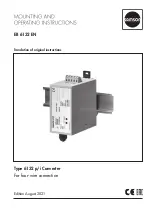
10
Battery Connection
Connect Fuse
In addition to the protection provided by the Inverter’s internal fuses, NEC article 551 requires that you connect your
Inverter’s positive DC Terminal(s) directly to a UL-listed fuse(s) and fuse block(s) within 18 inches of the battery. See
diagrams below for proper fuse placement.
WARNING! Never attempt to operate your Inverter by connecting it directly to output from an alternator
rather than a battery or battery bank.
CAUTION! Observe proper polarity with all DC connections. Reversed polarity will cause internal
damage to your Inverter.
Vehicular
Your Inverter’s Nominal DC Input Voltage must match the voltage of your battery or batteries—12 Volts in most vehicular
applications. It is possible to connect your Inverter to the main battery within your vehicle’s electrical system. In many
vehicular contexts, the Inverter will be connected to one or more dedicated auxiliary (house) batteries which are isolated
from the drive system to prevent possible draining of the main battery.
Note: Connection to all four DC terminals is recommended to
provide the maximum output power from PV3000HF models.
1
12 Volt Alternator
2
Vehicle Battery Ground
3
12 Volt Main Battery
4
12 Volt Auxiliary (House)
Battery
5
UL-Listed Fuses & Fuse
Blocks (mounted within
18 inches of the battery)
6
Battery Isolator
7
Large Diameter Cabling,
Maximum 00 Gauge to Fit
Terminals
8
8 AWG (minimum) Ground
Wire to Vehicle Frame or Earth
Ground
12 Volt Main Battery Connection—two DC terminals
12 Volt Main and Auxiliary (House) Battery Connection (Isolated Parallel)—two DC terminals
1
1
2
2
2
3
7
7
6
8
8
4
3
5
5
Note: Connection to all four DC terminals is recommended to
provide the maximum output power from PV3000HF models.











































